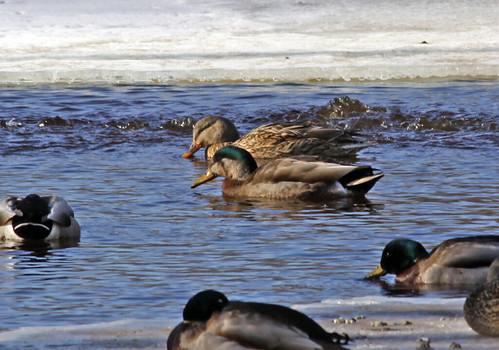 |
One of the depressing things about getting older is how our plumage changes. Not just the going gray, though that is certainly bad enough, but the odd little hairs that spring up, unbidden, on women’s chins and inside men’s ears and noses. As women’s estrogen levels ebb, and as men’s testosterone levels ebb, we lose muscle tone and gain wrinkles and embarrassing hairs, and there’s no turning back.
The same thing happens to birds. Right now (February 2009) in the big pond in Sapsucker Woods, at the Cornell Lab of Ornithology, there’s an older female Mallard who has developed what scientists confusingly call “intersex plumage.” They mean well—it just signifies a bird whose plumage has adopted some features of the opposite sex. In her case, her crown and nape are deep green and her body feathers don’t have the etching of normal female duck feathers, though the overall look is a bit browner than normal Mallard drakes.
She’s distinctive, and it’s good to know the reasons behind her plumage, but it irritates me that they call her an “intersex” Mallard, since despite her plumage, she’s genetically female, and physiologically so, too, enough that she is still probably producing healthy eggs.
She’s been seen in the pond regularly all winter, but so far doesn’t seem to have paired up with anyone, though the whole group is still apparently more into group dating than splitting into pairs at this point. In the world of birds, females and males can continue reproducing for a long time. A duck who is old enough to have developed what they call intersex plumage may not produce as many eggs anymore, but thanks to her years of experience may end up successfully raising more than the pretty young hen who hatched out just a year or two ago.
Many birds, male and female, develop tell-tale signs of advancing age, most of which actually make them more, not less, desirable as mates. Hawks called accipiters change their eye color, starting out yellow, advancing to orange, and ending up ruby red. Cedar Waxwings develop more and more little red spots on their wings as they get older. To signal females that a particular male, perfectly capable of breeding, has absolutely no experience in the matter, American Redstart males have a different plumage as one-year-olds than they will the rest of their adult lives.
American Robins seem to acquire more white patches on their plumage as they reach advancing ages. I’ve never seen one of these birds that wasn’t nesting, and the few times I’ve followed a nest to see how it succeeded, those white-feathered birds did just fine. No dyeing feathers to mask the gray for birds! Thinking younger is better is a mammalian, not an avian thing. You won’t find male birds plucking out their nose and ear hairs, you won’t find female birds injecting botulism or other poisonous stuff into their tissues to ward off wrinkles. Birds grab for all the gusto they can, every day of their lives, without endangering the rest of their lives trying to look younger than they are. That so-called intersex female mallard in Sapsucker Woods isn’t agonizing over her plumage change, and neither are the other mallards. Birds don’t need a TV commercial to tell them they’re not getting older, they’re getting better. They know it.